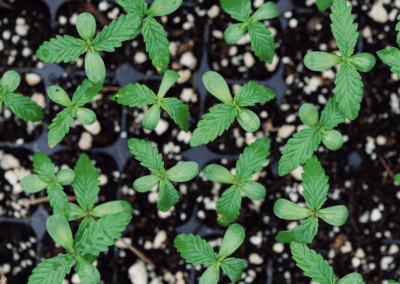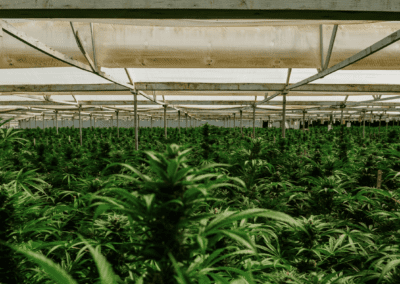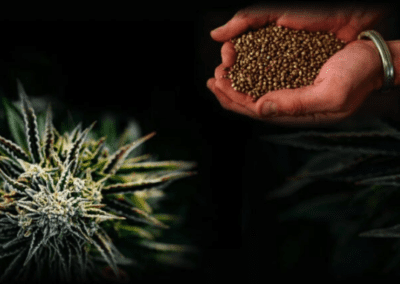Potency in the Cannabis Marketplace
The most important factor in Market Dynamics for a grower is potency, or more specifically, the percentage of THC in the flowers. A decade ago 10% was an acceptable average. Now, buyers balk at anything under 18%. This is the single characteristic in the sales process that can be quantified and so, in our cultural fanaticism for quantification, it has huge influence for buyers and for consumers. Nevermind that qualitatively THC percentages are only a piece of the pie, so long as there isn’t a lab test for it, it won’t help the negotiation. Connoisseurs understand that there is an “entourage effect” for any particular strain which is the cumulative influence of all the different cannabinoids present. There are at least 50 unique cannabinoids that we currently know of, and undoubtedly more to be discovered. But in today’s marketplace, THC is king.
We have embarked on a potency odyssey both as farmers and breeders over the past years that has revealed to us many peculiarities of the cannabis plant itself, sampling procedures, lab inconsistencies, and sales negotiations. We found that, for example, THC concentrations vary in a single plant from branch to branch. Additionally, we learned that THC production varies within a given population on a Bell curve; so sampling 50 sibling plants in a row, for example, will yield results from 9% to 22%
Illustration working off this graph and explanation, shows THC production distribution within a seed lot population, explains the high variation in THC between plants
Highest Potency Presents in most Vigorous Plants
This presents a unique set of challenges for the breeder, as potency is the single trait that cannot be seen or smelled! We have found, however, that the top performing plants in a breeding operation consistently produce the highest potencies. It is therefore not difficult to isolate and breed for potency when selecting for other desirable traits, which is why in general levels have risen by over 100% in the past few decades. Next is uniformity of potency in seed lots, a breeding endeavor we are actively working on.
Factors for Highest Potency: Nutrients & Average Temperature
Agronomists have explained to us that the nutrients that most directly influence potency are potassium and calcium. Most growers have their own opinions on the matter. What produces the largest increase in potency (other than selected genetics!) is average temperature in our experience. We have grown out identical clones and seed lots as our colleagues across the country and have determined time and again that where average temperatures (specifically night temperatures) are higher, potency is also higher. For this reason, and to speed growth in the earlier, colder months, we utilize black plastic mulch.
THC% / Potency as a Chemical Pest Deterrent
A deeper look into the actual plant’s reasons for producing THC contains some useful insights. Trichomes, the crystally, sticky, smelly substance on mature flowers, contains the majority of THC in the plant. Cannabis plants produce it as a pest deterrent, so insects and animals will not eat their reproductive parts. So mimicking pest pressure can cause plants to produce more trichomes. Products containing Harpin proteins supposedly have this effect, though at the time of this writing we do not have substantial evidence.
Potency Thresholds and Quantity / Dilution Dynamics
No matter your chosen genetics, average temperature, or products/nutrients applied, the potency can actually reach a critical threshold after which it declines. It is a classic quantity/dilution matrix: the plant will only produce so much THC. Therefore, the heavier or bigger the flower (more yield), the more diffuse the concentration of THC will be. For many varieties this threshold exists beyond the point of ripeness. But for some, and for most autoflowers, the intersection between yield and potency is a sweet spot. Finding it is highly dependent on your environment and may include assessing trichome color, flower density, and past experience.
Cannabis Potency Testing in the Laboratory
A final note on potency that bears mention for the cannabis grower is the mysterious world where laboratory science meets market regulations. Talk to any grower in California and you will hear any number of lamentations about labs. Many people have submitted identical flower samples to different labs and get potency results that vary significantly. Some, including us, have even submitted redundant identical samples to a single lab and received different potency results. Suffice it to say that the laboratory process to determine potency is inaccurate.
How the samples are actually taken is very important – some buyers have their own procedures, others rely on the grower to collect. Ideally the sample represents the entire harvest; but as noted above, high variation will be present no matter what. Therefore the best solution is an average potency reading. This, however, requires combining identical weights taken from flowers from multiple plants – a level of sophistication that is rarely achieved.
In the end, it’s a game. As long as growers choose good genetics, cultivate the crop well, and ensure high flower quality, potency will meet market criteria.



